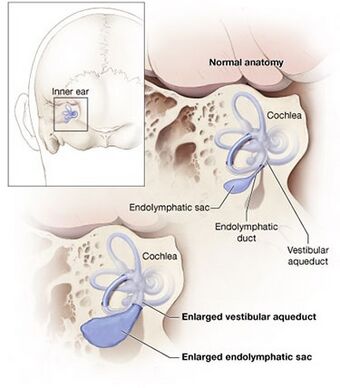Medicine:Pendred syndrome
| Pendred syndrome | |
|---|---|
| Other names | Goiter-deafness syndrome[1] |
 | |
| The normal cochlea has 2 & a half turns, but, in Pendred Syndrome, there is abnormal partitioning (the central bony core is reduced in size and complexity)and a reduced number of turns leading to a Mondini cochlea which has a basal turn and a dilated apical turn (1 & a half turns). There is also a dilated endolymphatic duct and sac with a widened vestibular aqueduct | |
Pendred syndrome is a genetic disorder leading to congenital bilateral (both sides) sensorineural hearing loss and goitre with euthyroid or mild hypothyroidism (decreased thyroid gland function). There is no specific treatment, other than supportive measures for the hearing loss and thyroid hormone supplementation in case of hypothyroidism. It is named after Vaughan Pendred (1869–1946), the British doctor who first described the condition in an Irish family living in Durham in 1896.[2][3] It accounts for 7.5% to 15% of all cases of congenital deafness.[4]
Signs and symptoms
The hearing loss of Pendred syndrome is often, although not always, present from birth, and language acquisition may be a significant problem if deafness is severe in childhood. The hearing loss typically worsens over the years, and progression can be step-wise and related to minor head trauma. In some cases, language development worsens after head injury, demonstrating that the inner ear is sensitive to trauma in Pendred syndrome; this is as a consequence of the widened vestibular aqueducts usual in this syndrome.[4] Vestibular function varies in Pendred syndrome and vertigo can be a feature of minor head trauma. A goitre is present in 75% of all cases.[4]
Genetics

Pendred syndrome is inherited in an autosomal recessive manner, meaning that one would need to inherit an abnormal gene from each parent to develop the condition. This also means that a sibling of a patient with Pendred syndrome has a 25% chance of also having the condition if the parents are unaffected carriers.[5]
It has been linked to mutations in the PDS gene, which codes for the pendrin protein (solute carrier family 26, member 4, SLC26A4). The gene is located on the long arm of chromosome 7 (7q31).[6][7] Mutations in the same gene also cause enlarged vestibular aqueduct syndrome (EVA or EVAS), another congenital cause of deafness; specific mutations are more likely to cause EVAS, while others are more linked with Pendred syndrome.[8]
Pathophysiology
SLC26A4 can be found in the cochlea (part of the inner ear), thyroid and the kidney. In the kidney, it participates in the secretion of bicarbonate. However, Pendred syndrome is not known to lead to kidney problems.[9] It functions as an iodide/chloride transporter.[10] In the thyroid, this leads to reduced organification of iodine (i.e. its incorporation into thyroid hormone).[6]
Diagnosis
People with Pendred syndrome present with a hearing loss either at birth or during childhood. The hearing loss is commonly progressive. In early stages it is usually a mixed hearing loss (both conductive and sensorineural hearing loss) because of a third window effect due to the inner ear malformation (widened vestibular aqueducts). A thyroid goitre may be present in the first decade and is usual towards the end of the second decade. MRI scanning of the inner ear usually shows widened or large vestibular aqueducts with enlarged endolymphatic sacs and may show abnormalities of the cochleae that are known as Mondini dysplasia.[4] Genetic testing to identify the pendrin gene usually establishes the diagnosis. If the condition is suspected, a "perchlorate discharge test" is sometimes performed. This test is highly sensitive, but may also be abnormal in other thyroid conditions.[4] If a goitre is present, thyroid function tests are performed to identify mild cases of thyroid dysfunction even if they are not yet causing symptoms.[11]
Treatment
No specific treatment exists for Pendred syndrome. If thyroid hormone levels are decreased, thyroid hormone supplements may be required. Patients are advised to take precautions against head injury.[11]
References
- ↑ RESERVED, INSERM US14-- ALL RIGHTS. "Orphanet: Pendred syndrome" (in en). https://www.orpha.net/consor/cgi-bin/OC_Exp.php?lng=EN&Expert=705.
- ↑ Pendred V (1896). "Deaf-mutism and goitre". Lancet 2 (3808): 532. doi:10.1016/S0140-6736(01)74403-0. https://zenodo.org/record/1982473.
- ↑ Pearce JM (2007). "Pendred's syndrome". Eur. Neurol. 58 (3): 189–90. doi:10.1159/000104724. PMID 17622729.
- ↑ 4.0 4.1 4.2 4.3 4.4 "Pendred syndrome--100 years of underascertainment?". QJM 90 (7): 443–7. July 1997. doi:10.1093/qjmed/90.7.443. PMID 9302427.
- ↑ "Pendred syndrome". Best Practice & Research. Clinical Endocrinology & Metabolism 31 (2): 213–224. March 2017. doi:10.1016/j.beem.2017.04.011. PMID 28648509.
- ↑ 6.0 6.1 "Pendred syndrome maps to chromosome 7q21-34 and is caused by an intrinsic defect in thyroid iodine organification". Nat. Genet. 12 (4): 424–6. April 1996. doi:10.1038/ng0496-424. PMID 8630498.
- ↑ "Pendred syndrome (goitre and sensorineural hearing loss) maps to chromosome 7 in the region containing the nonsyndromic deafness gene DFNB4". Nature Genetics 12 (4): 421–3. April 1996. doi:10.1038/ng0496-421. PMID 8630497.
- ↑ "Genotype-phenotype correlations for SLC26A4-related deafness". Human Genetics 122 (5): 451–7. December 2007. doi:10.1007/s00439-007-0415-2. PMID 17690912.
- ↑ "Pendrin, encoded by the Pendred syndrome gene, resides in the apical region of renal intercalated cells and mediates bicarbonate secretion". Proc. Natl. Acad. Sci. U.S.A. 98 (7): 4221–6. March 2001. doi:10.1073/pnas.071516798. PMID 11274445. Bibcode: 2001PNAS...98.4221R.
- ↑ "The Pendred syndrome gene encodes a chloride-iodide transport protein". Nature Genetics 21 (4): 440–3. April 1999. doi:10.1038/7783. PMID 10192399.
- ↑ 11.0 11.1 National Institute on Deafness and Other Communication Disorders (October 2006). "Pendred Syndrome". http://www.nidcd.nih.gov/health/hearing/pendred.asp.
External links
| Classification | |
|---|---|
| External resources |
 |
